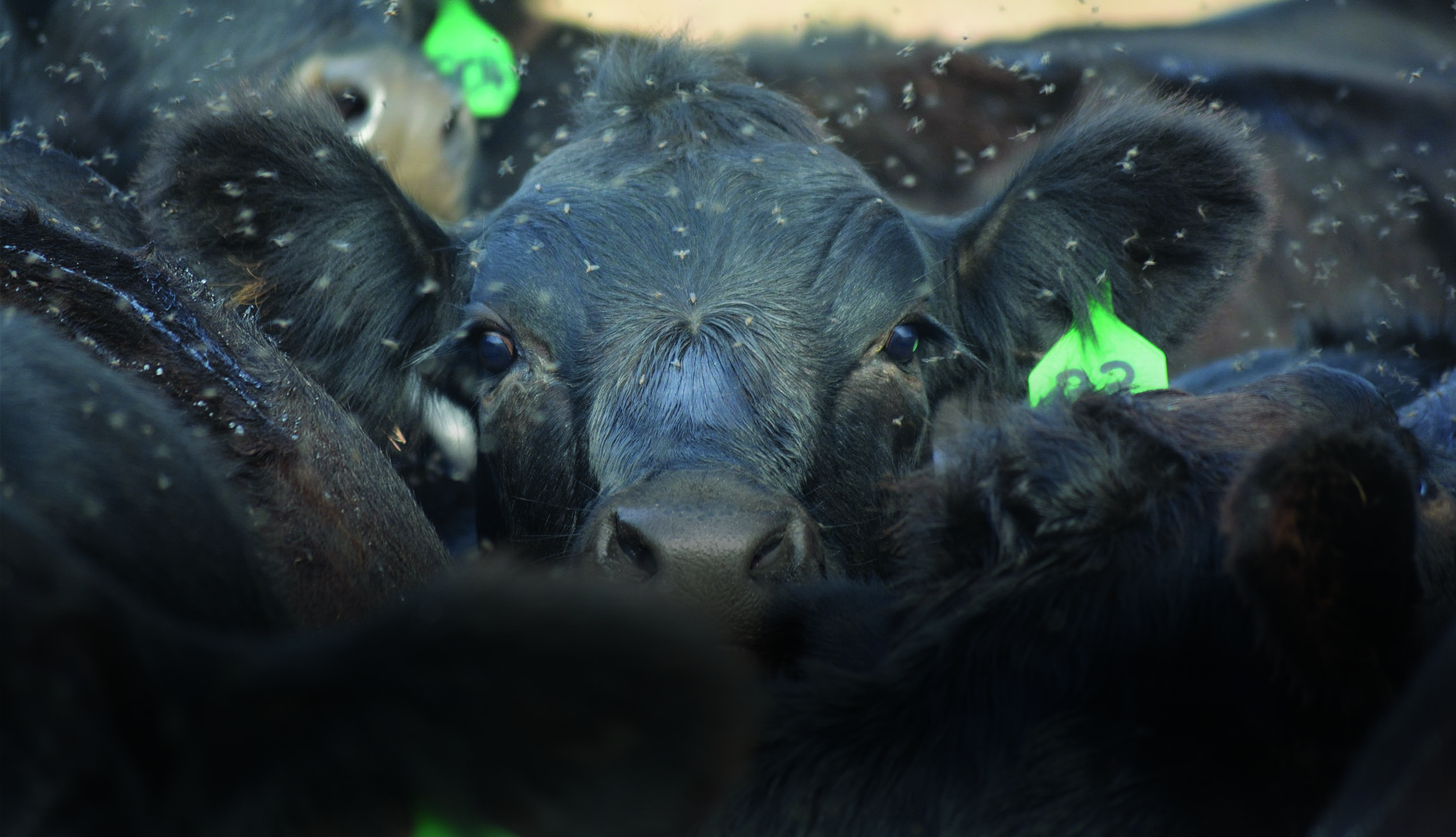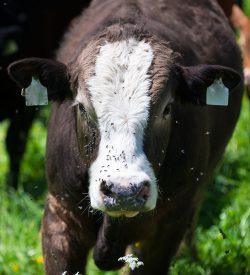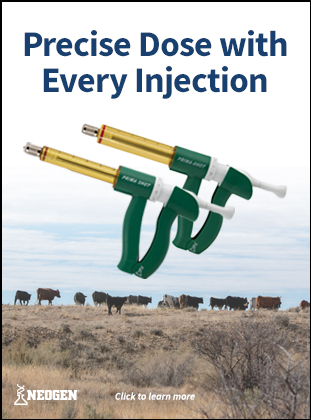Being In Control

Being In Control
By: Maura Keller
Fly control has long been a point of contention for cattle producers. Whether you manage 200 head of cattle in a smaller ranch, or 2,000 head of cattle in a feedlot, one thing’s for sure: Fly control is a top concern requiring diligence and understanding of the best products and procedures required to keep animals healthy.
As Frank Junfin, entomologist at Kunafin in Quemado, TX explains, the trends in fly control – basically fly control like many other control programs such as field crops, has been primarily the use of chemical insecticides. Kunafin, the producers of beneficial insects since 1959, has been promoting other important tools, such as an integrated biological control program using the natural enemy of the fly, the fly parasite.
“Remember, with fly control there are no magic bullets,” Junfin says. “There’s a process of using several tools and various products, so it’s important to work to establish a total and complete management program. We are constantly exploring new and better compatible solutions. Each operation has unique situations that we always are thriving to help find solutions because they all can be very different.”
Some of the biggest concerns regarding fly control within the cattle production environment is the cost of killing the pest, as producers are always looking for the minimal cost for the maximum amount of results..
Another concern pertains to disease issues as diseases are spread and carried by flies. There are also production problems as far as weight reduction, milk – quite simply, any reduction in an animal operation means there is reduction of their productivity due to a fly problem. So, when Kunafin first initiated the use of fly parasites in the animal industry over 60 years ago, the concerns were their viability and efficacy.
“We had to really prove the success and the sustainability of a biological integrated control program, and it took many years to overcome and turn doubters into believers, not only with producers but also within academia through education and direct demonstration,” Junfin says. So Kunafin has worked to educate and demonstrate the program with the many agriculture facilities worldwide. Through this Junfin and the Kunafin team have also shown a very important aspect of what the producer is doing and what can be accomplished.
“The positivity of using a biological integrated approach has substantially reduced the overuse of insecticides. Therefore, the producer is able to produce a safe product for the consumer, and as the times passed consumer knowledge of an agriculture facility using a Kunafin biological integrated program has brought a lot of good positive feedback to the producers,” Junfin says.
So what should ranchers look for in fly control and what common mistakes should they avoid?
Junfin says a producer should be looking for a good sound, common sense, fly management program. One of the most important things the producer needs to avoid is not to take the “magic bullet” syndrome approach.
“It is not chemical versus biological. It’s all about integration and it’s not waiting until flies are present in horrendous numbers and then react,” Junfin says, “It’s about thinking of prevention – whether it’s cleaning corals minimizing breeding areas, minimizing weeds, that’s all prevention. The use of beneficial insects, releasing beneficial insects, and the natural enemy of the fly – fly parasites – is also prevention. As the fly season progresses, if we need to do some reactive measures, there is still room for some of the approved insecticides that could be applied in conjunction with in a total full and complete program.”
According to M. Wayne Ayers, DVM, senior technical consultant at Elanco Animal Health, although the ranching industry has seen any new products that would fall into a new chemical class for fly control on or around cattle in several years, as the industry continues to learn more about flies in general and the economic impacts they can have for producers, industry professionals are looking at better ways to use the products currently available.
“We are also looking at the best ways to use fly control products that guard against the potential of resistance and encourage stewardship,” Ayers says.
Ayers points out that the need to understand flies and having choices of several products in different chemical classes is why entities, such as Elanco Animal Health becomes an solid choice as a rancher’s fly control partner. For example, Elanco has the largest and most diverse insecticide and parasiticide portfolio among animal pharmaceutical companies, allowing the company to help producers design better and more complete fly control programs across beef, dairy, poultry, and swine species. Because of the company’s broad portfolio made up of multiple insecticide classes, they can help with the rotation of chemical classes to reduce the risk of resistance in fly populations.
Dorane Strouse of Useful Farm Products says the biggest trend facing the fly control industry continues to be moving away from using harsh chemical sprays and to using better manure management and incorporating safe products like fly parasites and fly traps.
“The flytraps have become much better and more for specific flies,” says Strouse, who adds that most ranchers have larger pastures or rotate and don’t rely on fly control. Ranchers have to use fly control and use a wide variety of products from sprays, granular poisons, ear tags, fly parasites, sticky tapes, and a wide variety of traps. “Our preference is the parasites in combination with sticky tapes and non-toxic traps,” Strouse says.
When farmers and ranchers are looking for fly control products, several factors must be considered including the species of the fly, the time of year and the region within the U.S where they live.
“There are three major categories of fly control products: on-animal, premise and larvicides,” Ayers says. “The best fly control results from targeting flies with products from all three categories.”

There also are four major flies of concern: horn flies, face flies, stable flies and house flies. Each poses its own risk for producers and their cattle, including economic loss, the spread of disease and animal welfare,” Ayers says.
Horn flies pose a large risk because if they are not controlled, it can result in significant weight losses for cow-calf operations. “This can include up to 15 pounds of lost weaning weight per calf and for stocker cattle of up to 50 pounds of gain for the season,” says Ayers, who further explains that an adult horn fly lives on the cow its entire life, only leaving it to lay eggs in fresh feces. The fly feeds up to 30 times a day, taking a small blood meal of about 1 µl (microliter, 1/1000ml) at each feeding. An untreated cow can have 4,000 or more flies on it, which can mean approximately 120,000 bites per day, 5,000 bites every hour, resulting in blood loss of up to 120 mL per day.
“If a cow is being bitten frequently, not only will it not be able to graze as much as it should, leading to reduced milk production for her calf, but the blood loss and discomfort have a significant impact on the cow’s overall well-being,” Ayers says. “Uncontrolled face flies can result in losses due to transmission of Moraxella bovis, the organism that causes pink eye. Pink eye is very painful and can lead to vision loss if left untreated. Calves with a pink eye scar can bring $10-12 less/cwt than a calf without a pink eye scar. Cattle with as few as 12-14 Face flies graze about an hour a day less than cattle without face flies.”
Stable flies also bite cattle on the legs, causing significant pain and reducing the time spent eating. According to Ayers, this can lead to a decrease in average daily gain of 0.4 pounds The Stable fly bite is the most painful of the four mentioned flies, and the fear of being bitten causes cattle to crowd tightly together to avoid bites, putting the cattle in the center of the group at risk of heat stress in the summer.
“House flies are a nuisance for both humans and animals and have been shown to carry more than 100 different pathogens, including bacteria, viruses, fungi and parasites,” Ayers says. “Many of these organisms, such as Salmonella, can pose a serious health risk to both humans and animals. These flies can land on surfaces such as feedstuffs, milk and water buckets, transferring pathogens from place to place.”
Continuous Focus
Remember, it’s all about fly control program that is established.
“‘Program’ is a very important word. Just as we think about animal health, there’s not just one magic bullet to suffice. All your animal health needs, nutritional programs, do not rely on one product that’s going to give you the most amount for your gain or production. It’s all about the program,” Junfin says. “This includes the use of beneficial insects, fly parasites, the natural enemy of the flies, to be released early in the season and throughout the season to reduce adult fly emergence in an operation.”
Cleanliness is also paramount in helping minimize moisture in corrals, as well as manure management and weed management are also all very important in fly control.
There are certain considerations that cattle ranchers need to make as it relates to fly control that may differ for daily producers. As Strouse explains, no dairy can be without full scale fly control: manure management, fly prevention, fly elimination. Dairies take the calves off the mothers and put them in special calf areas which are notorious fly breeding areas and can lead to many diseases including pink eye.
“Most beef ranchers have an abundance of land and keep the young with the moms and don’t need strong fly control,” Strouse says. ‘Those in feedlots and confined areas do need the same: manure management, fly prevention and fly elimination.”
Ayers advises ranches and cattle producers that it’s important to approach fly control holistically. This means implementing a program that targets flies in as many ways as possible and where flies rest, feed, and breed.
“While it is important to choose individual fly control products that fit your operation, it may be equally or more important to manage facilities properly, properly apply the chosen products, and rotate product classes to achieve optimum fly control,” Ayers says.
It’s important to understand that an insecticide ear tag serves as a reservoir of sorts for cows to apply the product to their body daily. “Some believe ear tags emit some kind of aura that protects the cow in a bubble, which is not true,” Ayers says. “In reality, the cow spreads the chemical from the ear tag onto her body as she grooms herself. Additionally, she spreads it to her calf’s body as she grooms the calf, and as the calf rubs on her while nursing.”
For a cow-calf pair, an ideal application of insecticide ear tags includes three tags per pair. For the cow, one ear tag should be applied to the front of each ear, with the button on the back of the ear. As Ayers explains, the cow needs a tag in each ear to transfer chemical from the tag to the respective side of her body during normal grooming. For the calf, one ear tag should be applied on either ear.
“The purpose of the tag on the calf is to apply the chemical to the belly of the cow as the calf nurses and not necessarily to protect the calf,” Ayers says.
According to Ayers, it can take up to one week for the chemical in the ear tags to fully cover the cow’s body, so allowing time for the product to work is important.
“Because ear tags have a fixed life of efficacy, timing of application is also key. If applying ear tags too far ahead of fly season, the tags may become depleted before the end of the fly season,: Ayers says. “One may need supplemental fly control when tags near their life expectancy, whether applied too early or in regions with an extended fly season.”
In the end, Ayers agrees that effective fly control requires a well-planned program targeting flies where they rest, feed, and breed specific to the species being targeted.
“To increase one’s chances of successful fly control and maintaining cattle as comfortable and productive as possible, it is important to plan well ahead of the fly season,” Ayers says.
Strouse advises ranchers to start early, be aggressive and stay safe. “There is a famous saying, ‘One fly killed in May can mean 1,000 less in August.’ In less than a month a fly lives, it can lay 500 eggs and flies increase geometrically if not controlled. Be aggressive with your fly parasites, traps or whatever you use, more is always better,” Strouse says. “Many toxic sprays and chemicals have been eliminated by government regulation and flies have developed resistance to others. They certainly don’t help the health of your animals.”
For Junfin, beneficial insects are the most powerful, and basically the most reliable tool, for a fly control program.
“Just think about this way – honeybees! Everybody knows we need our honeybees to pollinate, we know how powerful they are. A few years back people were worried that our honeybee populations were very low, and people are very fearful that we will not have proper food production or maximum food production without enough honeybees,” Junfin says. “Well, this fly parasite, parasitic wasp is the natural enemy of the fly. It is host specific! It has no other host to rely on or to sustain itself on. Therefore, by releasing fly parasites they will work, they will search, they will find the fly pupa, and reproduce on this. Therefore, they are very, very important integral part of a fly management program.”



